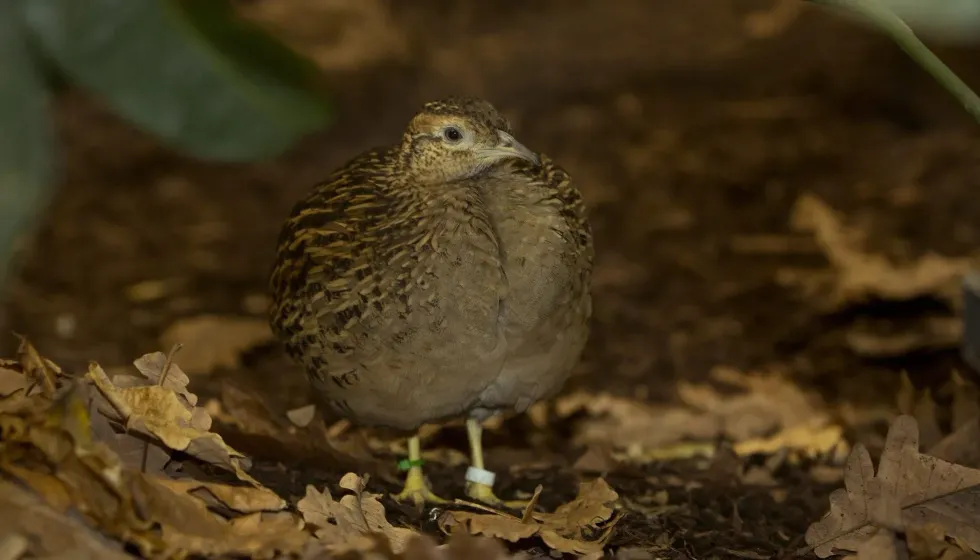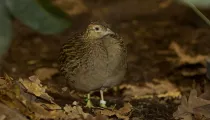The Chilean tinamou (Nothoprocta perdicaria) is a tinamou species of the family Tinamidae and order Tinamiformes. There are two subspecies of this bird, N. p. sanborni and N. p. perdicaria. These birds are also considered ratites, but unlike ratites, tinamous can fly.
The closest extant species of ratites are tinamous. The tinamous in the Nothoprocta genus are mostly gray-brown with buff, back, and white markings.
There are six recognized species in this genus. Nothoprocta has two Greek elements, 'nothos', meaning 'counterfeit' or 'spuriuos' and 'proktos', meaning 'tail' or 'hind part'. This word probably refers to their small tail with so many body feathers that makes the tail look fake.
Aridland tinamous or Nothurinae subfamily is one among the two subfamilies under Tinamidae. There are six genera with 18 species in Nothurinae.
These birds of this subfamily occupy South America. There are nine genera with 46 extant species in the Tinamidae family. Gauthier and de Queiroz (2001) defined the family Tinamidae.
If you enjoyed these facts about Chilean tinamou, then read our articles about the tinamou and robin on Kidadl.
Chilean Tinamou Interesting Facts
What type of animal is a Chilean tinamou?
The Chilean tinamou (Nothoprocta perdicaria) is a tinamou bird of the order Tinamiformes and phylum Chordata. The subspecies of this tinamou bird are slightly different from each other. This tinamou species is endemic to Chile and is mostly herbivorous. This bird is ground-dwelling, sedentary, and runs instead of flying when in danger.
What class of animal does a Chilean tinamou belong to?
The Chilean tinamou (Nothoprocta perdicaria) belongs to the class of Aves of animals.
How many Chilean tinamous are there in the world?
The exact population number of Chilean tinamous in the world is not known.
Where does a Chilean tinamou live?
The habitat range of the Chilean tinamou is across southern South America. The Chilean tinamou, as the name suggests, is an endemic bird of central Chile.
This bird can be found all over Chile except Antofagasta, Tarapaca, southern Los Lagos, Magallanes y Antartica Chilena, and Aisen. This bird has also been introduced to Easter Island. The distribution range of tinamous in Chile is around 46,000 sq mi (120,000 sq km).
The N. p. perdicaria subspecies range extends in the semi-arid grasslands in North Chile-Coquimbo, Atacama, Santiago, Valparaiso, O'Higgins, Nuble, and Maule regions. N. p. sanborni range extends in south-central Chile-Nuble, Maule, northern las Lagos region, adjacent Argentina, Bio-bio, and Araucania regions.
What is a Chilean tinamou's habitat?
The habitat range of this tinamou is in high-altitude shrubland in subtropical regions. The altitude range is 1,300-6,600 ft (400-2000 m) from the ground. This bird also prefers a habitat range in mountain forests with trees like endangered Jubaea chilensis, Acacia caven, and Porlieria chilensis.
Who do Chilean tinamous live with?
The Chilean tinamou lives in groups and pairs.
How long does a Chilean tinamou live?
The lifespan of this tinamou of Chile is not known. The tinamou birds live for 15 years.
How do they reproduce?
Not much is known about the breeding of Chilean tinamou. However, the females lay their eggs in a scrape and females lay around 10-12 glossy eggs. The male incubates these eggs and also raises the chicks. When the birds leave the eggs unattended they are covered with feathers.
The incubation period of the Chilean tinamou eggs is 21 days. The young immature birds are buff-colored with dark stripes. These birds run after hatching and when half-grown they fly. As they grow, gray or blue spots may appear.
It is known that during the breeding season, tinamous have distinctive calls. Also, male tinamous guard and maintain the breeding territory and nesting sites.
However, there have been reports where females were only seen caring for the young. It is believed that this happens if the male gets killed. Tinamous of the southern and open country only maintain territories during the breeding season and wander at other times.
What is their conservation status?
The conservation status of these tinamous is evaluated as Least Concern. However, conservation of this species is necessary as they face the threat of habitat loss and hunting.
Some tinamou species are vulnerable to illegal poaching and hunting. Hunters use flutes to imitate their call to get them out in the open during the breeding season. There needs to be proper control to protect these birds.
Chilean Tinamou Fun Facts
What do Chilean tinamous look like?
These tinamous are stocky in shape and are mostly tail-less. Their curved bill is similar to the California quail.
They have short and thick pale-yellow legs. Their short tail covers droop behind their legs and they usually walk upright. They have a striped upper body pattern which looks more complex.
This pattern extends to the side of their chest which is gray-colored. Their face is buffy with a small strip on the cheeks, dark eyeliner, and lightly colored crown.
These birds have brown necks with dark spots on the lower neck. These birds in the south of the Maule region have a brown-colored chest instead of a gray one, and the stripes are reddish-brown on their buttocks and upper body. The wings of these tinamous have large rounded wings covering the body when they are on the ground.
In-flight, the reddish-brown underside of the wings is visible. The small phallic organ in the cloaca of a female becomes larger in the breeding season.

We've been unable to source an image of a Chilean tinamou and have used an image of its habitat. If you are able to provide us with a royalty-free image of a Chilean tinamou, we would be happy to credit you. Please contact us at hello@kidadl.com.
How cute are they?
These tinamous of Chile are considered cute due to their stocky shape.
How do they communicate?
These tinamous communicate using vocals and body language. They have a distinctive call during the breeding season. Their call is 'swee wee'.
How big is a Chilean tinamou?
These tinamous of Chile measure up to 11 in (29 cm). Relatives of these tinamous, southern cassowaries, are almost five to six times longer than Chilean tinamous.
How fast can a Chilean tinamou fly?
These tinamous of the family Tinamidae are not strong-flying, like their relatives. The flight speed of this species is not known.
How much does a Chilean tinamou weigh?
These tinamous of Chile weigh around 4.4 lb (2 kg).
What are the male and female names of the species?
There is no specific name given to female and male Chilean tinamous.
What would you call a baby Chilean tinamou?
There is no specific name given to baby Chilean tinamous.
What do they eat?
The diet of these tinamous of Chile is mostly herbivorous. This species feeds on insects, worms, small vertebrates, seeds, and fruits.
Are they dangerous?
No, these tinamous of Chile are not dangerous to human beings. There are many natural predators of these tinamous like falcons, jaguars, vampire bats, skunks, foxes, armadillos, and humans.
Would they make a good pet?
No, this species of Chile would not make a good pet. These birds are wild animals.
Did you know...
There were efforts made to introduce and re-introduce tinamous in the 20th century in various regions of the world.
The Tinamidae family is the only family in the Tinamiformes order. The term 'tinamou' is a Galibi word for these birds.
There are 46 tinamou species found around the world. Some different types of tinamous are the Brazilian tinamou found in Amazonian South America. Brown tinamous are found in subtropical South America. Barred tinamous are found in northern parts of South America. All these species are of the genus Crypturellus.
Hooded tinamous occupy the forests of Peru and Bolivia. Highland tinamous are found in parts of Colombia, Peru, Venezuela, Ecuador, Panama, and Costa Rica. These species are of the genus Nothocercus.
The elegant crested tinamou is found in Argentina and southern Chile. There are nine subspecies of the elegant crested tinamou. This is of the genus Eudromia. Quebracho crested tinamous are also described within this genus.
Tinamou species are mostly diurnal, although these birds do become inactive at noon. When they are inactive, they feed or rest and at night, they are completely inactive.
Is the tinamou extinct?
Tinamous are not extinct. Although, their closest relatives are Extinct that are native to New Zealand according to 2010 research. Tinamous are vulnerable to poaching and hunting during the breeding season. Even expansion of land is a threat to these species.
Why are tinamou eggs colorful?
The eggs of tinamous have bright colors for other tinamou females to spot them easily. These females add their own eggs to each other's nests and they leave a male guarding these huge pile of eggs of different females.
Here at Kidadl, we have carefully created lots of interesting family-friendly animal facts for everyone to discover! For more relatable content, check out these secretary bird facts and Pesquet's parrot facts for kids.
You can even occupy yourself at home by coloring in one of our free printable Chilean tinamou coloring pages.









